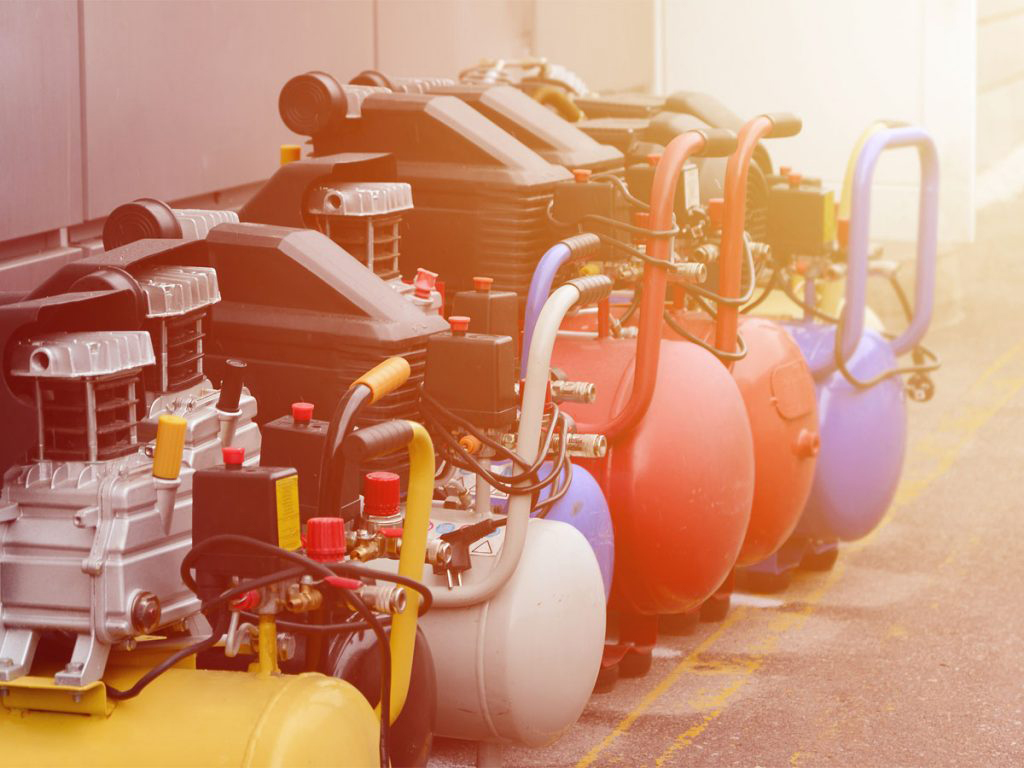If you are searching for “how do air compressors work” or “how air compressors work“, this post will be your guide!
How Do Air Compressors Work?
Air compressors operate by forcing air into a container, then pressurizing the air. The next step involves the air being forced through a tank opening, which causes the pressure to build up. The compressed air can be used as an energy when released. Powered by an engine that turns electrical energy into kinetic energy, air compressors use several unique parts, including a crankshaft, piston, valve, head and connecting rod, to complete the process.
Next, the pressurized air will be used to power several different tools. Some of the most popular options include sanders, paint sprayers, impact wrenches and nailers. There are a few different types of air compressors, yet the differences are not drastic.
Types Of Air Compressors
Here is a detailed look at some of the most common air compressors used today:
Reciprocating Air Compressors
Reciprocating air compressors are thought of as positive displacement devices, meaning they increase the pressure of the air by decreasing its volume. Basically, the compressor takes in successive volumes of air which is limited into a closed area and increasing the air to a high pressure. A piston inside the cylinder helps carry out this feat. These kinds of air compressors are available as “air cooled” or “water cooled” in lubricated or non-lubricated layouts and are also provided in a number of various pressures and capacities.
Rotary Screw Compressors
Another kind of air compressor is the rotary screw compressor that are positive displacement compressors. The more typical rotary screw compressors are the single-stage helical or spiral-lobe oil inundated screw air compressors. These kinds of air compressor comprise of 2 rotors in a casing, with the rotors compressing the air within. These types are oil-cooled, in which the oil seals the inner clearances and without valves.
Centrifugal Air Compressors
Dissimilar to the other 2 types, centrifugal air compressor are an active compressor that is based on the transferring of energy from a rotating wheel to the air. These compressors are designed for higher capacity since flow through the compressor is continual. These compressors are free of oil and the oil-lubed running-gear is separate from the air by shaft-seals and atmospherical venting.
Air Compressor Maintenance
Since air compressors require routine maintenance and periodic repair, preventative maintenance needs be done to have them working at maximum efficiency. We provides air compressor repair and preventative maintenance programs.
How Each Type Of Air Compressor Works
There are two basic methods towards achieving air compression: positive and dynamic displacement. Both methods will have several sub categories, which are highlighted below. While the process may differ a bit, the outcome will remain the same.
Dynamic Displacement
Utilizing a rotating blade, dynamic displacement compressors generate airflow through an engine. The air is then restricted to create pressure, mostly used in chemical plants. As is the case with positive displacement, there are two different types of dynamic compressors: axial and centrifugal.
Axial
These compressors use a series of blades to create air, forcing it through a small area. Very similar to other bladed compressors, axials operate with stationary blades, which slow airflow and increase pressure, at the same time. Axial compressors are mainly used in aircraft engines and larger air separation plants.
Centrifugal
Also known as radial compressors, centrifugal compressors work to bring the air into the center via a rotating impeller. The air is then pushed forward through centrifugal (outward) force. More kinetic energy is created by the slowing down the airflow. Centrifugal compressors are commonly used through HVAC systems.
Positive Displacement
Positive displacement air compressors will force air into a chamber. This is the area in the compressor where the volume is decreased. Positive displacement is an umbrella term used to describe different compressors that are powered via positive air displacement. Some types of positive displacement compressors are better equipped for industrial projects, while others are better used for private practices. Lets look at three main types of compressors that use positive displacement below.
Rotary Screw
These kind of air compressors feature two internal screws that rotate in opposite directions. The screws trap and compress air between them. These screws will generate constant movement as they rotate. This is generally seen as the easiest air compressor type to take care of.
Rotary Vane
Nearly identical to rotary screw, rotary vane compressors simply use vanes instead of screws for the air compressing process. The air will compress between the vane and its casing, then being pushed out through a different exhaust port. This type of compressor is most often used for private/small projects.
Reciprocating/Piston
A piston compressor uses pistons which are controlled by a crankshaft. This is used to deliver gas at a high pressure. Typically, this type is found at a smaller worksites.
There are two types of piston compressors, including:
- Single Stage.
- Two Stage.
Willing Service Corporation offers a full range of Air Compressors for sale nationwide!
Willing Service is proud to sell air compressors nationwide. You can choose the brand, model, and size you need for your purposes and we will ship it straight to your shop or business. Shop industrial air compressors online and get it touch with us today by giving us a call at (602) 246-6940.







